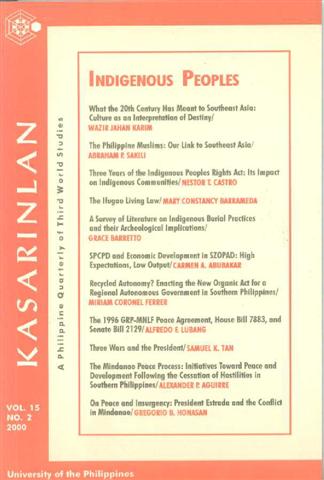SPCPD and Economic Development in SZOPAD: High Expectations, Low Output
Abstract
The Peace Agreement between the Philippine government and the Moro National Liberation Front (MNLF) signed in 1996 after the four years of negotiations under then President Fidel V. Ramos, was met with much publicity and opposition from, certain sectors of the Mindanao population. Implementing its promise of development was also not spared from criticism. But the weakness may be inherent to the terms of the agreement. For one, the powers and function of the Southern Philippines Council for Peace and Development (SPCPD) and the Consultative Assembly (CA) as mechanisms for the implementation of the Peace Agreement were limited by law. The SPCPD was not mandated to implement development projects but to coordinate and monitor projects being undertaken by line agencies that were reluctant to cooperate and credit their projects as part of the peace project. The CA was equally toothless as a forum to discuss and air problems in the SZOPAD areas. Budgetary and time constraints likewise hampered the efforts of the SPCPD and CA. Without sufficient funding support from the national government the project had to rely on supplementary donations from international organizations for the intensive development of SZOPAD areas. Three years were clearly not enough to turn Mindanao into an economic miracle or its leaders into development managers. The entry of government officials whose commitment to the Peace Agreement was not strong did not improve the situation either. However, the unrealized dreams of development cannot negate one accomplishment of the government - a moment of peace between two longtime enemies. The landmark peace treaty did bring peace, albeit, briefly to the war-torn region of Mindanao.
How to Cite
ABUBAKAR, Carmen A..
SPCPD and Economic Development in SZOPAD: High Expectations, Low Output.
Kasarinlan: Philippine Journal of Third World Studies, [S.l.], v. 15, n. 2, sep. 2007.
ISSN 2012-080X.
Available at: <https://journals.upd.edu.ph/index.php/kasarinlan/article/view/1647>. Date accessed: 16 sep. 2025.
Section
Features
Keywords
SPCPD, SZOPAD, MNLF, Fidel V. Ramos, CA, Mindanao
By submitting a manuscript, the authors agree that the exclusive rights to reproduce and distribute the article have been given to the Third World Studies Center.



